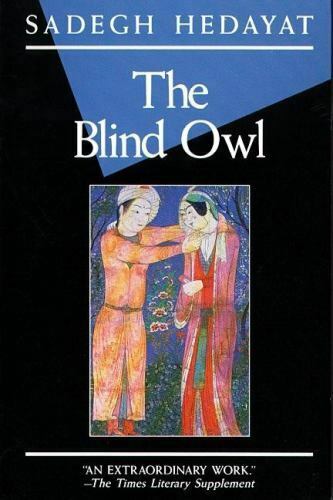 By SADEGH HEDAYAT (Grove Weidenfeld, 1959/94)
By SADEGH HEDAYAT (Grove Weidenfeld, 1959/94)
“There are sores which slowly erode the mind in solitude like a kind of canker.” That’s the opening sentence of THE BLIND OWL, and it adequately sets the tone for what follows. Twice adapted for film, it’s one of the most relentless and uncompromising studies of madness ever committed to paper, it remains one of the world’s great horror stories.
Sadegh Hedayat is widely recognized as the finest Iranian writer of the 20th Century. I’m far from an expert on Middle Eastern fiction and so can’t say how THE BLIND OWL fits in with the rest of its author’s oeuvre, and I probably missed the political subtext many critics have attributed to this creepy tale. To me it works, simply, as a superbly wrought psychological horror story by an author who later committed suicide…and so clearly knew of what he wrote.
The story is divided into two more-or-less distinct parts. The first involves a painter who finds himself increasingly obsessed with a beautiful woman he spies through his window one morning. When the woman shows up at his doorstep one day our “hero” is elated…but she unexpectedly dies after he gives her a drink from a bottle of old wine he vaguely remembers was “laid down on the occasion of my birth.” He paints her portrait and then, inexplicably, decides to chop her body up and bury it in a secluded area.
Guided by a hunched-over old man and two emaciated horses, the painter travels through an unearthly landscape of “ash-gray houses shaped like pyramids, cubes and prisms.” The old man bequeaths a jar he claims to have “found in the ground.” Arriving home, the narrator notices a picture on the jar of the very woman he just buried, and compares it with his own portrait of the woman. Sure enough, the paintings are identical. The segment ends with the protagonist taking refuge in opium-fueled oblivion.
Part two is far grimmer. The first-person protagonist this time around is slowly driven mad by his unbelievably shrewish wife, whom he identifies only as “The Bitch.” Finding himself drifting into an increasingly hallucinatory world, the poor guy eventually snaps and stabs the Bitch to death, only to catch a glimpse of himself in the mirror, finding that he’s turned into the likeness of the aforementioned hunched-over old man…
Yes, this book is a convoluted one that demands much from its readers. Hedayat never explains the narrative, although he does provide quite a few clues. Many elements recur throughout the two episodes: the vile old man, the emaciated horses, the strange geometric houses and that jug of wine the protagonist gives the woman in the first part, which is revealed in part two to have been poisoned with snake venom and bequeathed to him as a child by his mother.
Perhaps, as many have speculated, the idealized goddess woman of part one represents pre-Islamic Persia, while the unfaithful wife of part two is representative of Persia’s later period. To be sure, the book is extremely culture-specific, with the English version packed with footnotes explaining various native customs. But the author’s disturbing portrayal of a disintegrating mind is one that transcends cultures.
The writing, as translated by D.P. Costello, has a poetic, incandescent quality, particularly in the first part, which convincingly portrays an overwhelming longing that part two buries with ugly reality. It’s the passionate beauty of the prose that anchors the phantasmagoric narrative, suggesting a compelling rationale exists that’s worth our time to try and decipher.
